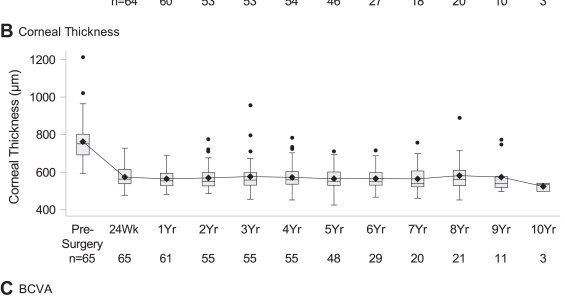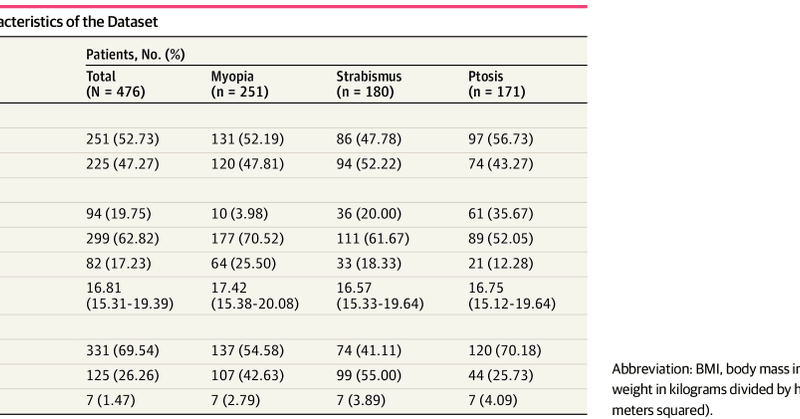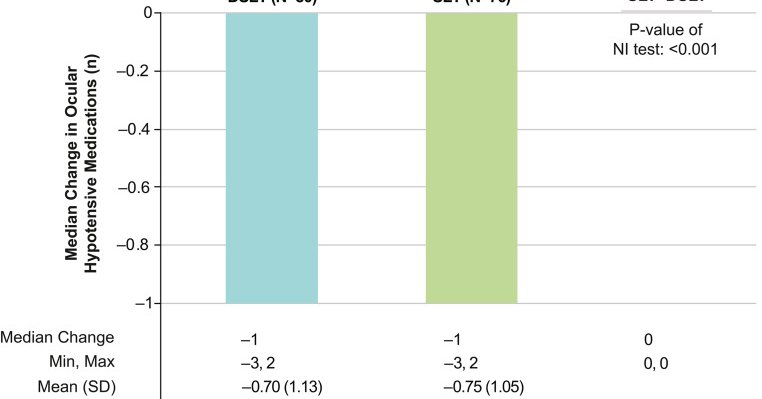
The Lens: Ophthalmology Research Newsletter
@TheLens_oph
Followers
4K
Following
789
Media
704
Statuses
3K
Weekly summaries of the most important new #research in #ophthalmology delivered to your inbox 📧 Visit our website (link below) to subscribe! 👀
Joined January 2020
Want to stay on top of the #ophthalmology literature? Subscribe to The Lens for short weekly summaries of the highest impact original research, delivered directly to your inbox! 📧📲 📚👀 Subscribe: https://t.co/5FUhywVOug
3
15
27
A new @BMJ_Ophth study finds augmented medial rectus recession achieves greater success and better alignment stability than botulinum toxin for acute acquired comitant esotropia. 👀🔪💉Read more:
pubmed.ncbi.nlm.nih.gov
ChiCTR2300068735.
0
0
0
Atropine for myopia—safe in the long run?. New @JAMAOphth study looks at long-term risk of using atropine for myopia control. Read more at https://t.co/CYUrWSe6y4
#JAMAOphthalmology #Myopia #Atropine
pubmed.ncbi.nlm.nih.gov
While the incidence of cataracts, glaucoma, or maculopathy was higher in children with myopia, atropine prescription was not associated with these risks. While these findings offer insights for...
0
0
0
(3/3) . Increase prednisolone acetate to q2H and start brimonidine B. Increase prednisolone acetate to q2H and start pilocarpine C. Decrease prednisolone acetate to qdaily and start latanoprost D. Decrease prednisolone acetate to qdaily and start timolol
0
0
0
(2/3) Now, he has an IOP of 26mmHg and has 1+ anterior chamber inflammation upon slit lamp examination. Which of the following is the next best step?
1
0
0
QOW (1/3): A 47yr old male presents with a 1-week history of idiopathic uveitis of the L eye and is currently taking prednisolone acetate 1% QID. 1 week ago, he had an IOP of 33mmHg and had 3+ anterior chamber inflammation.
1
1
0
Cultured cells, clear corneas. A new prospective study published in AAO evaluates the long-term efficacy of cultured human corneal endothelial cell transplantation. Read more at 🔗 https://t.co/s5iT8rARZz
#Ophthalmology
aaojournal.org
To investigate the long-term efficacy of cultured human corneal endothelial cell (CEC) transplantation with ρ-associated protein kinase (ROCK) inhibitor for the treatment of corneal endothelial...
0
0
0
Eyes on the future: AI recognizes myopia, strabismus & ptosis from a single smartphone snap in children. https://t.co/5JN7JsAeLo
#AIinMedicine #PediatricOphthalmology #Myopia #DigitalHealth #EyeScreening
jamanetwork.com
This cross-sectional study assesses whether a newly developed artificial intelligence (AI) model can accurately identify myopia, strabismus, and ptosis in children using mobile photographs.
0
0
0
New research demonstrates the distribution of uveal melanoma by state in the US. Read more on the newest United States epidemiologic data here: 🔗 https://t.co/6xaL1kjrul
#UvealMelanoma #Ophthalmology #Epidemiology #TheLens
pubmed.ncbi.nlm.nih.gov
This nationwide study refines US UM incidence estimates and highlights persistent disparities by sex, race, age, and geography. The high prevalence of secondary malignancies underscores the need for...
0
0
0
A new @BMJ_Ophth study found that temporary silicone oil tamponade achieved closure in 92.2% of persistent full-thickness macular holes with significant improvements in vision. Read more at:
pubmed.ncbi.nlm.nih.gov
Treatment of persistent FTMH with a temporary conventional silicone oil tamponade without retinal manipulation or postoperative positioning results in a high anatomical success rate and significant...
0
0
0
👁️ A new @AJOphthalmology study shows indirect corneal neurotization restores long-term sensation in neurotrophic keratopathy. 🔗Read more: https://t.co/2Uu1YvhoZW
#Ophthalmology #Cornea
pubmed.ncbi.nlm.nih.gov
STN/GAN-based ICN results in sustained corneal reinnervation, making secondary PKP possible for NK rehabilitation.
1
0
2
A new @JAMAOphthalmology study shows that patients in lower-wealth and rural communities are less likely to achieve intraocular pressure reductions and are more likely to be lost to follow-up. #JAMAOphthalmology #Glaucoma #HealthEquity
0
0
0
🚨New Research Alert 🚨: An international group of scholars was unable to prove non-inferiority of DSLT relative to SLT in the reduction of IOP. 🔗 https://t.co/0kXvigHEDQ
#Ophthalmology #Glaucoma #NoninvasiveTreatment
aaojournal.org
Effective glaucoma treatment is limited by nonadherence to medications and access to selective laser trabeculoplasty (SLT). The GLAUrious study compared automated, gonioscopy-free, noncontact,...
0
0
3
This increases osmotic pressure and causes lens swelling and opacification. Cataract extraction and intraocular lens placement are recommended. Trauma (Choice A) may lead to white cataract formation, but it is unlikely in a patient who does not report any traumatic incidents.
0
1
1
Galactosemia and Fabry disease (Choices B & C) are metabolic disorders that could lead to bilateral white cataracts; however, given the recent onset, this is unlikely. Source: Silverman J. I.M., Stiff HA, Fortenbach CR, Oetting TA. Diabetic White Cataract.
0
0
0
Poor glycemic control in diabetes can lead to earlier/rapid onset of cataracts (Choice D). In the aqueous humor, glucose is normally metabolized by the lens. In a hyperglycemic state, normal glucose metabolism becomes overwhelmed, leading to a buildup of sorbitol/fructose.
0
1
1
What is the most likely cause of the cataract?
3
0
0
He takes insulin intermittently for his type 1 diabetes. On exam, his visual acuity is hand motion at 2 feet in both eyes. A dense white cataract is seen bilaterally. The rest of the exam is within normal limits. A picture of the right cataract is shown below.
1
0
0
A 21-year-old male was referred to the clinic for evaluation of bilateral white cataracts. At age 18, he started to lose significant vision. Now, he reports he can only see lights and shadows. He does not report any past ocular history or surgery.
1
1
1
From no light perception to 20/25! Read about the first reported case of cortical blindness reversal following #Tenecteplase administration here: https://t.co/TkosaWi3G1
#StrokeTwitter
pubmed.ncbi.nlm.nih.gov
Clinicians should be aware of the various treatment options in acute ischemia related cortical visual loss such as TNK. Future providers should also add comprehensive ophthalmological exam before and...
0
0
2
Researchers are demonstrating that large language models can be used to support the diagnosis and management of a variety of eye conditions. https://t.co/lPZ2awES11
#AIinMedicine #Ophthalmology #DigitalHealth
pubmed.ncbi.nlm.nih.gov
DeepSeek-R1 outperformed OpenAI o1 in diagnosis and management across subspecialties while lowering operating costs, supporting the potential of open-weight, reinforcement learning-augmented LLMs as...
0
2
1







